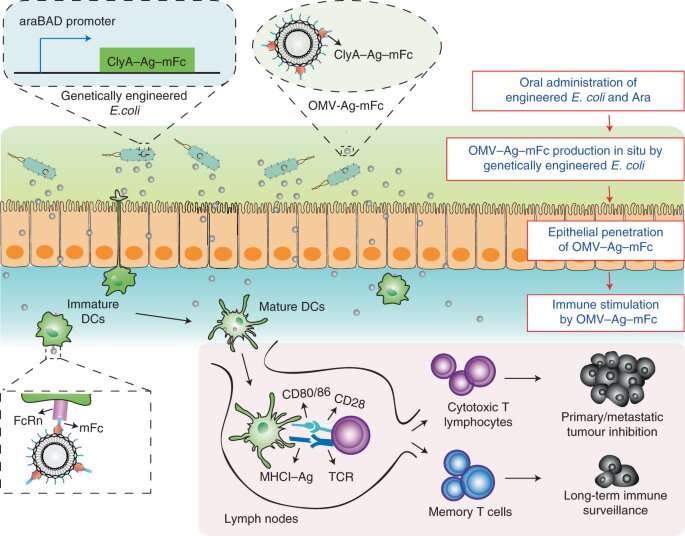Orally administered tumor vaccine shows promise in animal models

In a study published in Nature Biomedical Engineering, a research team led by Prof. Nie Guangjun and Prof. Zhao Xiao at National Center for Nanoscience and Technology (NCNST) of the Chinese Academy of Sciences demonstrated that orally administered bacteria can be an effective vaccine carrier to secrete small membrane vesicles in the gut as a tumor vaccine to fight against cancer in animal models.
Compared with vaccination, oral vaccines are much easier to take, and mostly lower in cost. More importantly, oral vaccines activate the body's adaptive immune response by stimulating the immune cells in the intestine, which is the largest immune organ. Therefore, such vaccines could generate strong immune responses. However, the oral vaccine system is still very limited. There are two major challenges for the development of an orally administered tumor vaccine. One is the harsh environment in digestive tract, and the other is the complex intestinal epithelial barrier.
To overcome these challenges, the researchers developed an oral sugar-controlled bacteria robot to produce a tumor vaccine in the gut. They designed a bacterial robot based on genetically engineered E. coli that can secrete outer membrane vesicles (OMVs) carrying tumor antigens under the induction of arabinose, a five-carbon sugar found widely in nature.
As a natural mediator for interaction between the gut microbiota and the body's immune system, OMVs, together with tumor antigens, can effectively penetrate the intestinal mucus and epithelial barrier and be taken up by antigen-presenting cells in lamina propria, one special layer of mucosa of the gut. Ultimately, the oral vaccine system activates strong antitumor immune responses and immune memory effects in multiple preclinical tumor models.
"Initially, a report of bacterial enteritis by food contamination came to our attention. If pathogenic bacteria can break through biological barriers and provoke an immune response, artificial engineered bacteria should be able to overcome the complex gastrointestinal environment. Inspired by this hypothesis, we started to try to use bacterial robots to deliver oral vaccines," said Prof. Zhao. "However, bacteria are too large to penetrate the thick mucus layer and intestinal epithelial barrier to reach the immune cells at lamina propria. Fortunately, numerous studies have demonstrated that OMVs released by intestinal bacteria are involved in the immune regulation of the body."
"This work shows that this oral bacteria robot can controllably produce vaccines against multiple tumors in mice with the help of genetic engineering technology. What's more, it can be used as an antigen delivery and display platform to prevent other disease such as contagion. It holds great promise for further development of oral vaccines," said Prof. Nie.
More information: Yale Yue et al, Antigen-bearing outer membrane vesicles as tumour vaccines produced in situ by ingested genetically engineered bacteria, Nature Biomedical Engineering (2022). DOI: 10.1038/s41551-022-00886-2

















